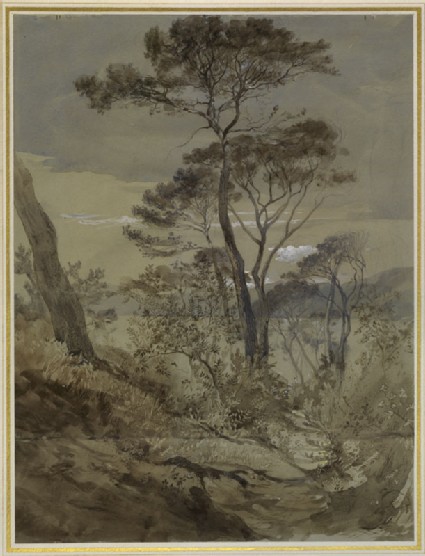Search Results: objects
Show search help- Reference URL
Actions
Stone Pines at Sestri, Gulf of Genoa John Ruskin
-
Curator’s description:
Description
The drawing is dominated by a single pine tree, surrounded by others, smaller and less well-defined. An uneven path leads down the hillside, and the sea and a distant coastline can be glimpsed through the trees. On 29 April 1845 Ruskin wrote home that he planned to 'make studies of stone pine' (H.I. Shapiro, Ruskin Family - Ruskin in Italy: Letters to his Parents, Oxford (Clarendon Press): 1972, letter 19). His next letter relates that he had been 'working like a horse, and have got a most valuable study of stone pine ... Air all scented by the pines and wild flowers - and the birds singing so loudly you can hardly hear the sea'. (Shapiro, letter 20)
Ruskin first catalogued the drawing in 1870, listing it as no. 10 in the Educational series in the "Catalogue of Examples". The following year, he moved it to frame 13 in case I of the series, "Introductory Subjects, and Exercises in Flower Drawing" (Educational Catalogue, 1st edition). By 1874, the drawing had been re-numbered as no. 22, although its position remained the same (Educational Catalogue, 2nd edition). In the 1878 reorganisation of the collection, however, Ruskin intended to move the drawing to the Rudimentary Series where, as no. 295, it would have been part of a series showing how to depict plants. It seems, from his description in the catalogue, that the drawing was originally partly obscured by its mount (Rudimentary Series, manuscript catalogue).
Ruskin included the drawing in the collection both as an example of speedy but accurate depiction, and because of the association of the stone pine with Poseidon. He wrote to his father in 1852 that, in 1845, 'I went into Italy with a new perception of the meaning of the words drawing and chiaroscuro. My first attempts with my new perception were those of the stone pines at Sestri, now in your bedroom' - the drawing he later placed in the Drawing School (XXXVI.131).
-
Details
- Artist/maker
-
John Ruskin (1819 - 1900)
- Object type
- drawing
- Material and technique
- graphite and pen with washes and white bodycolour on off-white paper
- Dimensions
- 442 x 334 mm
- Associated place
-
- Europe › Italy › Liguria › Sestri Levante › Sestri Levante (subject)
- Inscription
- Verso, right of centre, the Ruskin School's stamp
- Provenance
-
Presented by John Ruskin to the Ruskin Drawing School (University of Oxford), 1875; transferred from the Ruskin Drawing School to the Ashmolean Museum, c.1949.
- No. of items
- 1
- Accession no.
- WA.RS.ED.022
-
Subject terms allocated by curators:
Subjects
-
References in which this object is cited include:
References
Taylor, Gerald, ‘John Ruskin: A Catalogue of Drawings by John Ruskin in the Ashmolean Museum, Oxford’, 7 fascicles, 1998, Oxford, Ashmolean Museum, no. 019
Ruskin, John, The Diaries of John Ruskin, ed. Joan Evans and John Howard Whitehouse, 3 (Oxford: Clarendon Press, 1956-1959), pl. 24, between pp. 320 & 321
Ruskin, John, Catalogue of the Educational Series (London: Smith, Elder, 1871), cat. Educational no. 13
Ruskin, John, Catalogue of the Educational Series (London: Spottiswoode, 1874), cat. Educational no. 22
Ruskin, John, Catalogue of Examples Arranged for Elementary Study in the University Galleries (Oxford: Clarendon Press, 1870), cat. Educational no. 10
Penny, Nicholas, Ruskin's Drawings, Ashmolean - Christie's Handbooks (London: Phaidon, 1988), no. 9
Ruskin, John, ‘Rudimentary Series 1878’, 1878, Oxford, Oxford University Archives, cat. Rudimentary no. 295
Ruskin, John, ‘The Works of John Ruskin’, Edward T. Cook and Alexander Wedderburn, eds, The Works of John Ruskin: Library Edition, 39 (London: George Allen, 1903-1912), vol. IV, pl. 12, f.p. 346
Ruskin, John, ‘The Ruskin Art Collection at Oxford: Catalogues, Notes and Instructions’, Edward T. Cook and Alexander Wedderburn, eds, The Works of John Ruskin: Library Edition, 39 (London: George Allen, 1903-1912), 21, cat. Educational no. 22
Ruskin, John, ‘Praeterita: Outlines of Scenes and Thoughts Perhaps Worthy of Memory in My Past Life’, Edward T. Cook and Alexander Wedderburn, eds, The Works of John Ruskin: Library Edition, 39 (London: George Allen, 1903-1912), 35
Ruskin, John, ‘The Letters of John Ruskin’, Edward T. Cook and Alexander Wedderburn, eds, The Works of John Ruskin: Library Edition, 39 (London: George Allen, 1903-1912), 36-37
Location
-
- Western Art Print Room
Position in Ruskin’s Collection
Ruskin's Catalogues
-
Ruskin's Educational series, 1st ed. (1871)
13 Stone Pines at Sestri, Gulf of Genoa. M -
Ruskin's Educational series, 2nd ed. (1874)
22. Stone pines at Sestri, Gulf of Genoa. M -
Ruskin's Catalogue of Examples (1870)
10. Pine, for Poseidon.Study of trunks of stone-pine at Sestri, in the Gulf of Genoa. Pencil, secured with pen outline, and a slight wash of sepia. It is a good way of studying trees hastily.
-
Ruskin's revision to the Rudimentary series (1878)
Edu. 22 295.Study of my own at the ‘Promontory of Sestri’, giving example of the application of these various methods, with the utmost possible speed consistent with care. The whole drawing was done in a day and there is another Stone-pine concealed by the Mount more elaborate, but less satisfactory than those below, which, therefore, are alone shown. [I see two spots of mildew on the sky and suspect a slight alteration of colour here & there in Washes from the same cause. At all events their fault is being too uneven.]






